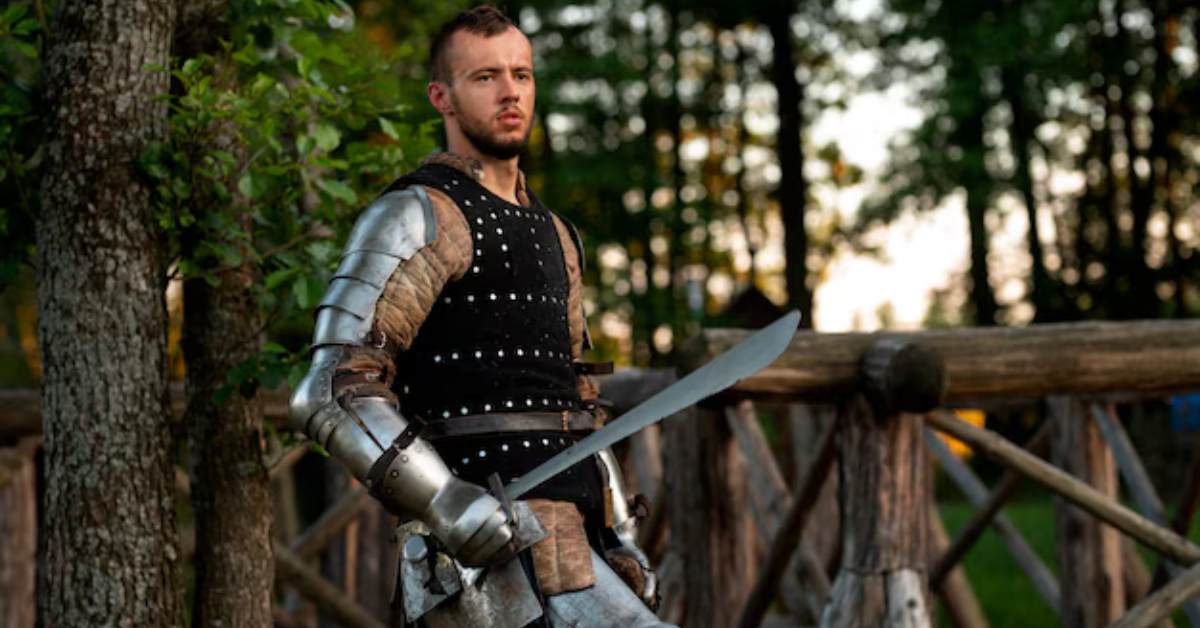From medieval battlegrounds to contemporary reenactments, the Gambeson has withstood the test of time as one of the most versatile forms of body armor.
A gambeson is a padded garment, often quilted and worn under chainmail or plate armor.
Historically, it served as standalone armor and protective padding, making it invaluable to soldiers across Europe, Asia, and beyond.
While its primary function was protection in battle, the gambeson has a rich legacy and an enduring appeal.
Today, it is cherished by history enthusiasts, reenactors, and artisans alike for its historical significance, practicality, and the artistry involved in creating it. This article explores the gambeson’s gambeson’s history, construction, and modern uses, shedding light on why it remains relevant and admired even today.
What is a Gambeson?
A gambeson is padded armor made from layers of fabric, typically stuffed with wool, cotton, or horsehair and quilted to hold the stuffing in place.
This thick, quilted garment was designed to absorb and dissipate the force of blows from weapons, providing a lightweight yet effective form of protection.
The gambeson could be worn alone as armor or paired with chainmail or plate armor for additional protection.
Its structure made it highly flexible and breathable, ideal for knights and soldiers who needed protection and mobility.
A Brief History of the Gambeson
The origins of the gambeson can be traced back to early medieval Europe, around the 10th century. Initially used as standalone armor by foot soldiers, the Gambeson quickly gained popularity due to its effectiveness and affordability. Here’s a closer look at its historical significance:
- Medieval Warfare
During the Middle Ages, soldiers wore gambesons under their chainmail to protect against bludgeoning and cutting forces. The quilted layers absorbed the impact of blows, reducing injury from swords, arrows, and maces. This made the Gambeson an essential piece of armor for both infantry and cavalry. - Versatility and Accessibility
Unlike plate armor, which was costly and typically reserved for the nobility, gambesons were more affordable and accessible to ordinary soldiers. This accessibility made it a staple for armies throughout Europe, and it could be crafted by local tailors and artisans, furthering its appeal. - Cultural Variations
While the gambeson is most commonly associated with medieval Europe, variations of padded armor existed worldwide. In Japan, padded garments called tatami-do served similar purposes, and in the Middle East, quilted armors were known as zırh. - Decline and Revival
The popularity of gambesons began to decline with the rise of gunpowder and firearms in the 16th century. However, they have seen a resurgence in modern times among reenactors, history enthusiasts, and craftspeople passionate about historical armor.
Craftsmanship and Structure of a Gambeson
The construction of a gambeson is an art form involving skilled craftsmanship and attention to detail. Creating a high-quality gambeson requires:
- Selection of Materials
Traditional gambesons were crafted from durable fabrics like linen, cotton, or leather, with inner layers made from wool, cotton, or horsehair. Modern gambesons may also use synthetic materials for comfort and durability. - Layering and Quilting
The defining feature of a gambeson is its layered, quilted construction. The padding is sandwiched between layers of fabric, stitched to secure the stuffing and provide. Quilting enhances the armor’s strength and allows for greater flexibility and mobility. - Tailoring and Fit
Gambesons were often custom-made to fit the wearer’s body shape. This ensured optimal protection and comfort. The tailoring involved careful measurements and adjustments to allow for a snug fit while accommodating additional armor like chainmail if needed. - Durability and Maintenance
Gambesons are surprisingly durable due to their construction but require maintenance. Medieval soldiers would often repair tears, patch worn areas, and clean their gambesons to maintain effectiveness in battle. Today, reenactors and collectors follow similar care routines to preserve their gambesons.
Modern Uses and Popularity of the Gambeson
The gambeson has experienced a revival in recent years, finding new relevance among various groups and activities:
- Historical Reenactments and Festivals
Reenactors and participants in medieval fairs and festivals frequently wear gambesons as part of their costumes. They appreciate the authenticity gambesons provide and the protection they offer during mock battles. - Martial Arts and Combat Sports
Gambesons are often used in Historical European Martial Arts (HEMA), a modern sport that recreates medieval combat techniques. In HEMA, gambesons protect practitioners from accidental injuries during sparring and practice. - Theater and Film
Costume designers in theater and film production often incorporate gambesons into medieval-themed projects. Their authentic look and historical accuracy make them a preferred choice for period films and stage productions. - Collectors and History Enthusiasts
Gambesons have become a collector’s item, with many history enthusiasts displaying them in private collections or museums. The craftsmanship and history behind each gambeson make it a unique armor representing centuries of warfare and tradition.
Why the Gambeson Endures: Benefits and Appeal
The enduring popularity of the gambeson can be attributed to its practicality, comfort, and historical value. Here are some reasons why it continues to be cherished:
- Affordable Protection: Unlike full plate armor, a gambeson is relatively inexpensive, providing solid protection without the high Cost.
- Mobility and Comfort: The gambeson’s padded construction allows for flexibility, making it comfortable for extended wear, whether for reenactments or martial arts.
- Authentic Historical Appeal: The Gambeson offers history enthusiasts a connection to the past. Its design has remained essentially unchanged, preserving the spirit of medieval warfare.
- Adaptability: The gambeson can be customized to fit a wide range of body types, and the materials used in construction can vary based on individual preference.
Challenges and Considerations in Owning a Gambeson
While gambesons offer many benefits, there are a few considerations to keep in mind:
- Weight and Warmth: A gambeson can be pretty warm due to its thick padding, making it uncomfortable in hot weather. The weight can also be significant, especially if worn for long periods.
- Maintenance Needs: To ensure longevity, gambesons require regular maintenance, including cleaning, repairing tears, and storing in a dry place to prevent mold or mildew.
- Limited Protection Against Modern Weapons: While effective against medieval weapons, gambesons offer little protection against modern firearms or sharp weapons like knives.
Frequently Asked Questions (FAQ)
1. What is a gambeson used for?
A gambeson is a type of padded armor used for protection in battle. It can be worn alone or under chainmail or plate armor to absorb the force of weapon blows.
2. How is a gambeson made?
Gambesons are made by layering fabric, typically cotton or linen, and filling it with padding such as wool, horsehair, or cotton. The layers are then quilted together to hold the stuffing in place.
3. What materials are used to make a gambeson?
Traditional gambesons were made from natural linen, cotton, and wool. Modern gambesons may also use synthetic materials for comfort and durability.
4. How do I care for a gambeson?
Regular maintenance includes cleaning, storing in a dry place, and repairing tears. Many reenactors and collectors also apply unique treatments to prevent fabric degradation over time.
5. Can a gambeson be worn in hot weather?
Due to its thick padding, a gambeson can be warm to wear, which can be uncomfortable in hot weather. Some people prefer lighter materials or wear them during cooler seasons.
6. Is a gambeson suitable for modern martial arts?
Gambesons are widely used in HEMA (Historical European Martial Arts) as protective gear, especially during practice and sparring.
7. Can I make my gambeson?
Yes, with suitable materials and sewing skills, many enthusiasts create custom gambesons for personal use in reenactments or martial arts.
8. Is a gambeson effective against firearms?
Gambesons were designed for medieval warfare and were not effective against modern firearms. They protect against cuts and blunt force but offer limited resistance to bullets.
Conclusion
The gambeson is more than just armor; it is a remarkable piece of history that embodies the ingenuity and resilience of medieval warfare. Its layered construction, affordability, and versatility made it a staple on battlefields for centuries.
Today, the Gambeson’s legacy endures captivating reenactors, martial artists, and history enthusiasts worldwide.
Whether you’re interested in its historical value or practical applications in modern combat sports, the Gambeson remains a testament to its timeless appeal.






